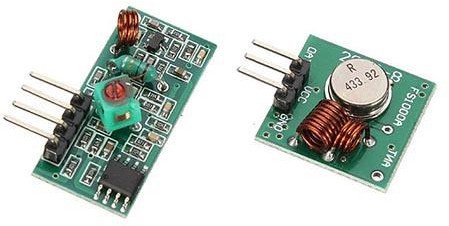433 MHz Transmitter/Receiver
The 433 MHz Transmitter and Receiver modules are widely used for short-range wireless communication in DIY electronics projects. Operating in the 433 MHz ISM (Industrial, Scientific, and Medical) band, these modules are commonly used for simple communication tasks like remote controls, wireless sensors, and home automation systems. The transmitter sends a modulated signal (usually data) to the receiver, which decodes and processes it.
The 433 MHz modules are inexpensive, easy to use, and typically communicate using Amplitude Shift Keying (ASK) modulation. The transmitter takes data from a microcontroller and transmits it via an antenna, while the receiver listens for signals and sends the received data to the microcontroller for processing. These modules often work over distances ranging from 50 meters to 100 meters in open spaces, but the range can be affected by obstacles and interference.
These modules use a simple digital signal interface and can be integrated with microcontrollers like Arduino for wireless data transmission. They are often used in projects like wireless weather stations, garage door openers, and remote monitoring systems. Despite their simplicity, they are suitable for low-data-rate applications. However, they have limited data transfer rates and are prone to interference, which can be mitigated with proper encoding and error-checking techniques.
The 433 MHz modules are inexpensive, easy to use, and typically communicate using Amplitude Shift Keying (ASK) modulation. The transmitter takes data from a microcontroller and transmits it via an antenna, while the receiver listens for signals and sends the received data to the microcontroller for processing. These modules often work over distances ranging from 50 meters to 100 meters in open spaces, but the range can be affected by obstacles and interference.
These modules use a simple digital signal interface and can be integrated with microcontrollers like Arduino for wireless data transmission. They are often used in projects like wireless weather stations, garage door openers, and remote monitoring systems. Despite their simplicity, they are suitable for low-data-rate applications. However, they have limited data transfer rates and are prone to interference, which can be mitigated with proper encoding and error-checking techniques.
